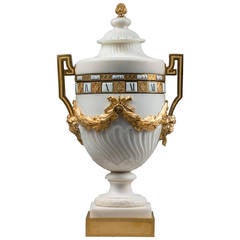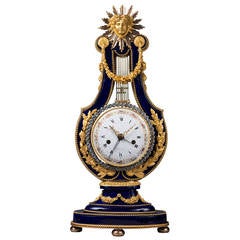Gilt Mantel Clocks
3
756
to
59
494
188
756
756
756
161
109
54
51
27
8
8
8
6
5
4
3
2
1
70
643
43
29
10
3
4
1
1
1
1
1
1
Height
to
Width
to
741
614
249
245
188
728
681
17
14
7
15
14
8
6
6
Technique: Gilt
“Cercles Tournants” Louis XVI Mantel Clock, Bronze Attributed to Gouthière
By Pierre Gouthiere
Located in Paris, FR
Important white marble “Cercles Tournants” mantel clock.
Gilt bronze mounts attributed to Pierre Gouthière.
Paris, Louis XVI period, circa 1775...
Category
1770s French Louis XVI Antique Gilt Mantel Clocks
Materials
Marble, Bronze
Sèvres Porcelain Louis XVI Lyre Mantel Clock by Kinable, Dial by Dubuisson
Located in Paris, FR
Dieudonné Kinable
Enamel Dial Attributed to Dubuisson (1731-1815)
Exceptional Porcelain Lyre Mantel Clock from the Royal Sèvres Porcelain Manufactory
Paris, late Louis XVI period, circa 1785-1790
Height 62 cm; width 26 cm; depth 16 cm
The round enamel dial, signed “Kinable”, indicates the hours in Roman numerals, the fifteen-minute intervals in Arabic numerals, the annual calendar and the signs of the Zodiac, by means of four hands, two of which are made of pierced gilt bronze, the two others in blued steel. The magnificent lyre-shaped case is made of “bleu nouveau” Sèvres porcelain and finely chased and gilt bronze. The bezel is made up of a gilt bronze twisted rope; the pendulum is adorned with brilliant-cut paste stones; the body of the lyre is adorned with gilt bronze beading and with laurel leaf and seed motifs, with two rosettes issuing floral and foliate swags. The clock is surmounted by a mask with radiating sunrays. The spreading foot is decorated with beading and twisted rope motifs and a leafy garland. The en-suite decorated oval base is raised upon four flattened ball feet.
The Royal Sèvres Porcelain Factory produced the lyre clock model as of 1785. Four colours were offered: turquoise, green, pink and bleu nouveau. These exceptional clocks were made for the connoisseurs of the time. Louis XVI had a similar clock in his Salon des jeux in Versailles; its dial bore the signature of the clockmaker Courieult (this is almost certainly the example illustrated in P. Verlet, Les bronzes dorés français du XVIIIe siècle, Paris, 1999, p. 41). Kinable, however, was the clockmaker who purchased the greatest number of lyre cases from the factory, and he developed the model in the late 18th century. Among the porcelain lyre clocks signed by this brilliant horologer, one example is in the Victoria & Albert Museum in London (illustrated in H. Ottomeyer and P. Pröschel, Vergoldete Bronzen, Band I, Munich, 1986, p. 252, fig. 4.6.26). A second such clock is in the Royal British Collection (see C. Jagger, Royal Clocks, The British Monarchy & its Timekeepers 1300-1900, 1983, p. 130, fig. 176).
Bibliography:
M. Gay and A. Lemaire, “Les pendules lyre”, in Bulletin de l’Association nationale des Collectionneurs et Amateurs d’Horlogerie ancienne, Winter 1993, n° 68, p. 5-40.
Dieudonné Kinable (active circa 1785-1810)
One of the most important Parisian clockmakers of the late 18th century. His shop was located at n° 131 Palais Royal. He purchased a great number of lyre-type porcelain clock cases...
Category
1780s French Louis XVI Antique Gilt Mantel Clocks
Materials
Bronze
Recently Viewed
View AllMore Ways To Browse
Antique Gilt Bronze French Mantel Clock
Clock Winding Keys
Standing Bell
Bronze And White Marble Clock
French Ormolu Porcelain Clock
Set Of Four Gold Gilt Bronze
French Bow Ormolu
Brass Clock Set
Napoleon Iii Clock Bronze
White Gold Mantel Clock
Glass Bronze Bell
Paris Porcelain Ormolu
White Beaded Object
1870 Bronze Clocks
Large Bronze Mantel Clock
White Porcelain Clock
Large French Clock Face
French Porcelain Cherub

